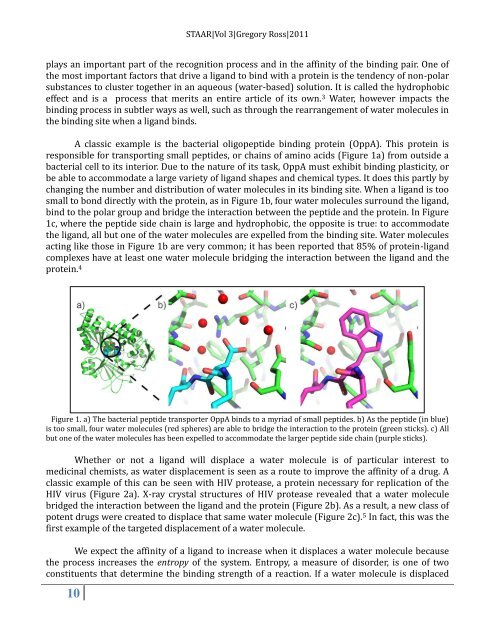STAAR Volume 3 - St. Anne's MCR
STAAR Volume 3 - St. Anne's MCR
STAAR Volume 3 - St. Anne's MCR
Create successful ePaper yourself
Turn your PDF publications into a flip-book with our unique Google optimized e-Paper software.
10<br />
<strong>STAAR</strong>|Vol 3|Gregory Ross|2011<br />
plays an important part of the recognition process and in the affinity of the binding pair. One of<br />
the most important factors that drive a ligand to bind with a protein is the tendency of non-polar<br />
substances to cluster together in an aqueous (water-based) solution. It is called the hydrophobic<br />
effect and is a process that merits an entire article of its own. 3 Water, however impacts the<br />
binding process in subtler ways as well, such as through the rearrangement of water molecules in<br />
the binding site when a ligand binds.<br />
A classic example is the bacterial oligopeptide binding protein (OppA). This protein is<br />
responsible for transporting small peptides, or chains of amino acids (Figure 1a) from outside a<br />
bacterial cell to its interior. Due to the nature of its task, OppA must exhibit binding plasticity, or<br />
be able to accommodate a large variety of ligand shapes and chemical types. It does this partly by<br />
changing the number and distribution of water molecules in its binding site. When a ligand is too<br />
small to bond directly with the protein, as in Figure 1b, four water molecules surround the ligand,<br />
bind to the polar group and bridge the interaction between the peptide and the protein. In Figure<br />
1c, where the peptide side chain is large and hydrophobic, the opposite is true: to accommodate<br />
the ligand, all but one of the water molecules are expelled from the binding site. Water molecules<br />
acting like those in Figure 1b are very common; it has been reported that 85% of protein-ligand<br />
complexes have at least one water molecule bridging the interaction between the ligand and the<br />
protein. 4<br />
Figure 1. a) The bacterial peptide transporter OppA binds to a myriad of small peptides. b) As the peptide (in blue)<br />
is too small, four water molecules (red spheres) are able to bridge the interaction to the protein (green sticks). c) All<br />
but one of the water molecules has been expelled to accommodate the larger peptide side chain (purple sticks).<br />
Whether or not a ligand will displace a water molecule is of particular interest to<br />
medicinal chemists, as water displacement is seen as a route to improve the affinity of a drug. A<br />
classic example of this can be seen with HIV protease, a protein necessary for replication of the<br />
HIV virus (Figure 2a). X-ray crystal structures of HIV protease revealed that a water molecule<br />
bridged the interaction between the ligand and the protein (Figure 2b). As a result, a new class of<br />
potent drugs were created to displace that same water molecule (Figure 2c). 5 In fact, this was the<br />
first example of the targeted displacement of a water molecule.<br />
We expect the affinity of a ligand to increase when it displaces a water molecule because<br />
the process increases the entropy of the system. Entropy, a measure of disorder, is one of two<br />
constituents that determine the binding strength of a reaction. If a water molecule is displaced


